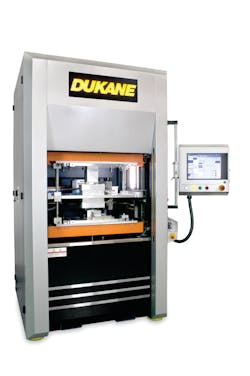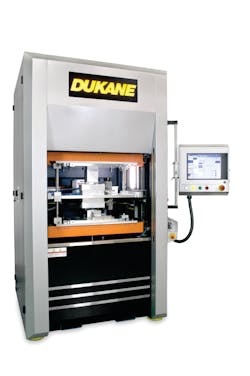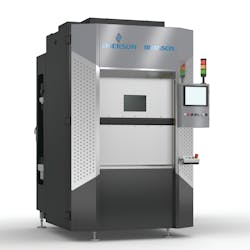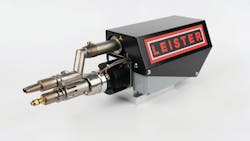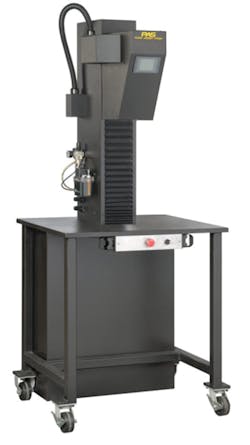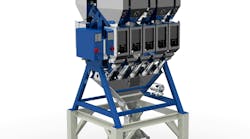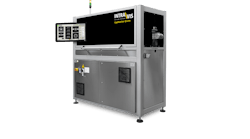DUKANE WELDER COMBINES THREE PROCESSES
Dukane has launched its new TH3-2040 thermal hybrid welder for hot-gas, infrared and hot-plate welding.
The company says the platform is an industry first, in that it can perform three welding functions.
Dukane has identified manufacturers of automotive, appliance and medical device parts as some of the plastics processors who could benefit from having the versatility and cost-savings associated with a hybrid welder. All three welding processes are commonly used to create hermetic seals and can achieve weld strengths approaching that of the rest of the material, according to the company.
The TH3-2040 is a triple-axis servo- welding platform suited for contoured or complex thermoplastic parts, the company said. It includes fully programmable servo controls for the upper and lower tools and a heater profile for each weld setup. The precision of servo-controlled motion improves the accuracy, reliability and repeatability of the welding process. Operators can program multiple functions for different setups and store them in the system.
The upper and lower tools are programmed to locate, vacuum-hold and eject parts, which reduces errors and scrap.
The TH3-2040’s benefits include intuitive programming and setup, rapid changeover between hot-plate and infrared tools, particulate-free welding options (with hot-gas and infrared welding), precise and repeatable welding processes and high-speed, smooth servo motion. Multiple platen sizes are available.
A 14-inch-by-32-inch platen is the most popular, according to the company. However, it also is available with a larger 20-inch-by-40-inch platen and a smaller 12-inch-by-12-inch platen. The company also can build a custom-sized platen.
EMERSON INTRODUCES BRANSON LASER WELDER
Emerson’s Branson GLX-1.5, the latest model in its Branson GLX series of laser welders, is designed to support the growing demand for high-quality, geometrically complex plastic parts that have demanding aesthetic requirements.
The GLX Laser Series uses the company’s patented Simultaneous Through-Transmission Infrared (STTIr) laser welding technology, which the company said combines superior weld strength and quality with speed and flexibility. STTIr is highly repeatable and stable, achieving successful welds more than 95.5 percent of the time, the company said.
STTlr welds entire seams all at once, for weld times of 0.5 second to 5 seconds.
STTIr technology produces particulate- free welds without vibration for intricate 3-D parts, delicate components and embedded electronics and sensors. Emerson said the GLX-1.5 is ideal for welding automotive components — such as instrument clusters — medical devices and consumer electronics where aesthetics, quality and weld performance are important.
The GLX series lets designers incorporate barely visible, particulate-free weld lines into large part designs for superior aesthetics, maximum strength and exceptional production efficiency, the company said.
The new welder features a lift table measuring about 31 inches by 20 inches.
Herrmann cooling sleeve reduces cycle times
Herrmann Ultrasonics has developed a cooling sleeve to reduce the temperature of its sonotrodes during ultrasonic welding, which can minimize cycle times. The sleeve is available with new welders and as a retrofit for existing ultrasonic welders; it is standard with all welders installed for staking applications.
To keep sonotrode temperatures low, the new technology guides compressed air through a sleeve surrounding the sonotrode. This forced cooling method can reduce sonotrode relative temperatures by as much as 79 percent and stake cooling times by as much as 23 percent. The company said that installations in the facilities of auto parts makers have proved successful and it now is welcoming inquiries from companies in other market segments.
High sonotrode temperatures can result in longer cycle times and frequency changes. Other, less-sophisticated methods of cooling include using holes in the sonotrode, but this can lead to cumbersome design and manufacturing of the tools, according to Herrmann. Often, internal and improper cooling leads to higher air costs and increased risk of breaking the sonotrode. The cooling sleeve is four to five times more effective at cooling the sonotrode and maintaining cooler surface temperatures, the company said.
Reducing the sonotrode temperature also improves process stability and protects against converter damage from overheating.
KAMWELD INDUSTRIES LAUNCHES TEMPERATURE CONTROLLER
Kamweld Industries’ new device sets and controls the temperature of any Kamweld hot-air gun, including welders used to assemble plastic parts.
The KAM-TC1000 controls the hot-air gun’s temperature to within 2 degrees Fahrenheit.
The new system consists of a sensor port and controller. Users attach the hot-air gun to a compressed air source.
Kamweld also introduced the KAM-TC2000, which combines the KAM-TC1000 with the company’s 43HS-900, a heavy-duty hot-air gun for welding thermoplastics.
Purchasing the devices together saves customers money compared with buying the products separately, said David Best, Kamweld’s executive VP of operations.
The 43HS-900 is for medium- and high-speed welding of thermoplastics with welding speeds up to 60 inches per minute using round or triangular tips, the company said. The standard stainless- steel heating element is rated at 900 watts. It can be used with all types of weldable thermoplastics having a minimum thickness of 0.0625 inch.
The temperature controller has numerous applications.
“It’s used in a variety of different industries, from automotive to semiconductors and everything in between,” Best said. “For example, for the semiconductor industry, it is very important for these guys to not only be able to control the temperature of the air coming out of the nozzle, but they need to take measurements. They need to certify this plastic weld was welded at X number of degrees, plus or minus a tolerance of, let’s say, 2 degrees, for example.”
The KAM-TC1000 offers precise temperature control at a lower price than previously available products, he said.
LEISTER WELDERS FIT ON ROBOTS
Leister Technologies has introduced two modular thermoplastic extrusion welders designed to perform automated tasks.
Leister introduced the two models in March. They can be mounted on a robot arm and tied into a plastic processor’s existing controller to coordinate its operation with other equipment in the work cell.
“Up until our tools, what was going on is people would take a portable extrusion welder and connect it to a robot and try to grab its controls and functions and somehow automate it, which is very difficult to do,” Rothbard said.
“What we’ve done is, we’ve separated out the front-end components of the portable extrusion welder and allow integrators to use all their controls, and all their motors, gearing, whatever items they are familiar with and like to use, and they can integrate it into a solution so they are not just strapping a portable extrusion welder onto a robot, which can work, but only to a limited degree.”
The communication, drive components and interfaces are chosen by the end user or integrator based on individual preferences and the given application, he said. Electrical and mechanical connection points are designed for convenient integration of additional modules such as a heater and blower and sensors to control the temperature and speed of the blower.
The WeldPlast 200-i weighs 33 pounds fully assembled and can apply up to 4.4 pounds of a molten plastic material per hour to the parts that it joins. It can be used with a variety of thermoplastics commonly used in additive manufacturing, including HDPE, LDPE, PP, PVC, polyvinylidene fluoride, ABS, PC, polyamide, PS and PU. In addition to welding plastic parts, it can be used as a print head to make 3-D parts through extrusion.
The WeldPlast 600-i weighs 50 pounds fully assembled and is capable of an output of up to 13.2 pounds per hour of HDPE, LDPE or PP in automated extrusion welding applications.
Portable extrusion welders are capable of welding larger plastic parts than many other technologies.
“If you look at ultrasonic and laser [welding], those are usually for smaller parts,” Rothbard said.
Those two technologies aren’t designed for welding large plastic tanks or large truck bodies, but portable extrusion welders excel at those tasks, he said.
PAS UNGRADES SERVO HEAT-STAKING MACHINE
Plastic Assembly Systems (PAS) recently added new advanced features to several of its servo-driven heat-staking machines that allow for fast tool changes.
The new features, included on the STS 2000, STS 4000 and STS 4000H models, allow users to change the machine’s tools without the need for hand tools, and“The tooling automatically aligns the upper tooling to the lower tooling, so there is no setup required by the operator,” Mauro said.
The technology uses codes to match the appropriate upper and lower tools to each other.
“What does this mean to the end user?” Mauro asked. “When the tooling set is installed in the machine, the upper and lower tooling make electrical and pneumatic connections automatically. The machine then knows which lower tool is loaded in the machine and changes the machine program to that stored machine recipe.”
The machine also confirms that the lower and upper tools match and will perform heat-staking only if they do.
Once the tooling is in place, software automatically loads the appropriate recipe, which includes information about the machine’s home position (the location where the machine tools retract after every cycle) and the final weld depth (or the final position of the tools during staking). Using the advanced features, the final weld depth is accurate and the tooling position moves in 0.1-inch increments, providing very precise control of the staking process and allowing users to stake materials, like elastomers, that previously could not be staked, Mauro said. Also included in the stored recipes are all temperature settings.
Another new feature lets the operator program the machine’s motions by first moving its components manually.
Once the setup has been completed, users can test the programming prior to running a part to ensure all parameters were inputted properly.
SEDECO EXPANDING ULTRASONIC LINE
Sedeco is expanding its SonoPet J II series of ultrasonic welders with two new 19.15 kilohertz (kHz) models.
The SonoPet J II 410 and J II 910S 19.15 kHz welders will join models that operate at 28 kHz and 39.5 kHz.
The new models will be capable of welding larger surface areas and performing a more penetrative weld, meaning they can melt plastic further away from the contact point without damaging surrounding plastic, said Alex Moorehead, chief sales and applications engineer for Sedeco.
“The [19.15 kHz] version of this welder can basically cover a larger surface area, or it can do a more penetrative weld,” he said. “With [19.15 kHz], you can send the vibration further through the plastic than just where you are touching, and you can melt a little further away from your contact point.”
One example of where a 19.15 kHz welder would excel would be welding heavy plastic battery casings, he said.
The difference between the SonoPet J II 410 and the SonoPet J II 910S will lie in the maximum wattage output. The 410 will operate at a maximum of 450 watts, while the 910S will operate at a maximum of 950 watts. The 410 model will feature a more compact transducer, and, in cases where lesser wattage is acceptable, it will save space and work better in robotic welding.
Welders in the J II series are compatible with numerous high-speed data communication standards so they can easily be integrated with centralized production-management systems.
Digital controls keep the amplitude of the tool horn constant, which contributes to stable welding, reduces welding time and increases productivity, Moorehead said.
The J II Plus app for smartphones and tablets provides an intuitive interface with which to monitor the performance and condition of J II welders and adjust settings. J-Tool Welding Management Software for Windows computers allows similar monitoring for all SonoPet J II welders.
Sedeco said it will begin shipping the 19.15 kHz ultrasonic welders early next year.
SONICS ENCLOSURE REDUCES NOISE
Ultrasonic welding can increase the noise on the shop floor. To address the issue, last month, Sonics & Materials introduced a sound enclosure for its 15-kHz bench-top welding presses.
Ultrasonic welding presses come in a variety of frequencies, but most operate in the 15- to 40-kHz range. Some people can hear frequencies in the 15- to 20-kHz range and can experience discomfort around equipment emitting those frequencies.
“This way, the operator and anybody in the vicinity of the welding application will not be exposed to the noise levels that might come out of the machine,” said Brian Gourley, welding group sales manager.
The enclosure is built out of extruded aluminum pieces bolted together with sound-absorbing materials. The rectangular enclosure features three hinged access doors, a sliding access door and noise-abating foam. The enclosure also contains interior LED work lights.
A console featuring two operating buttons, an emergency-stop button and a light to signal when the welding cycle is complete can be mounted on the exterior of the enclosure, which measures 30 inches wide, 36 inches deep and 60 inches tall. The company plans to release a smaller sound enclosure for Sonics’ line of 20-kHz welding presses later this summer. Sonics is selling the enclosures as an option with new systems, but owners of existing presses may buy them as a retrofit.
THERMAL PRESS UPDATES SERVO OPTIONS
Thermal Press International (TPI) manufactures machines, automation systems and tooling packages for heat staking, heat sealing and thermal assembly applications. The machines also thermally activate and set adhesives to assemble a wide variety of plastic parts and films that are used by customers in the medical, automotive, telecom, consumer electronics and aerospace industries.
TPI offers standard pneumatic actuators and for the last three years has offered a servo actuator option. The servo option on the Thermal Press machines offers improved accuracy to within 0.0005 inch, compared with standard pneumatic systems that have an accuracy to within 0.001 inch, the company said. The repeatability also was improved to within 0.00025 inch.
This year, the company updated the servo- driven actuator option to offer improved recipe- driven programmable motion profiling, positioning and timing controls.
“The servo option has been in use for three years, but we are creating more features within the servo, such as controlling the force applied by the press, instead of only the time it applies heat and the distance it travels,” President Ian McLean said. “We also now are getting feedback onto our computer screen about what the servo is actually doing, compared to what we are telling it to do.”
The update gives operators the ability to create a quality control alarm for minimum and maximum forces that could be used to flag a good assembly from a bad assembly, said Lance Crawford, VP of sales.
“We already have a programmable quality control alarm for position, now we also have one for force,” Crawford said. For example, the updated servo could apply 10 pounds of force, hold that force for a programmed period of time, and then adjust to a different force. These programmable features can now be stored on the updated servo.
About 30 percent of customers are selecting the servo option when buying a press, which costs about $8,000 more than the pneumatic option, McLean said.
Bruce Geiselman, senior staff reporter
Senior staff reporter Bruce Adams contributed to this article.
Contact:
The Branson Ultrasonics brand of Emerson Electric Co.,
Danbury, Conn., 203-796-0400, www.emerson.com/Branson
Dukane,
St. Charles, Ill., 630-797-4900, www.dukane.com
Herrmann Ultrasonics Inc.,
Bartlett, Ill., 630-626-1626, www.herrmannultrasonics.com
Kamweld Industries Inc.,
Norwood, Mass., 617-558-7500, www.kamweld.com
Leister Technologies LLC,
Itasca, Ill., 855-534-7837, www.leister.com
Plastic Assembly Systems,
Bethany, Conn., 203-393-0639, www.heatstaking.com
Sedeco USA Inc.,
West Chester Township, Ohio, 513-644-2369, www.sedecousa.com
Sonics & Materials Inc.,
Newtown, Conn., 203-270-4600, www.sonics.com
Thermal Press International Inc.,
Livermore, Calif., 925-454-9800, www.thermalpress.com
